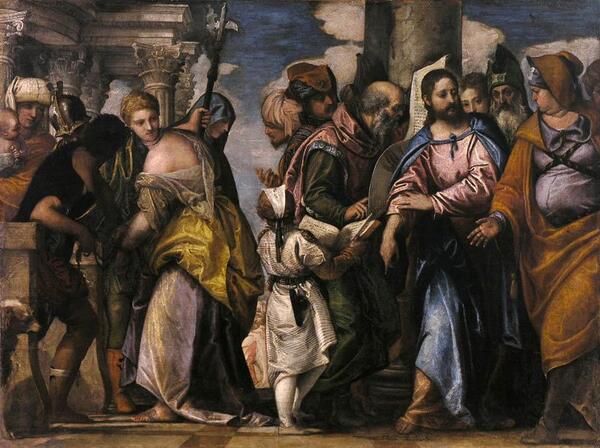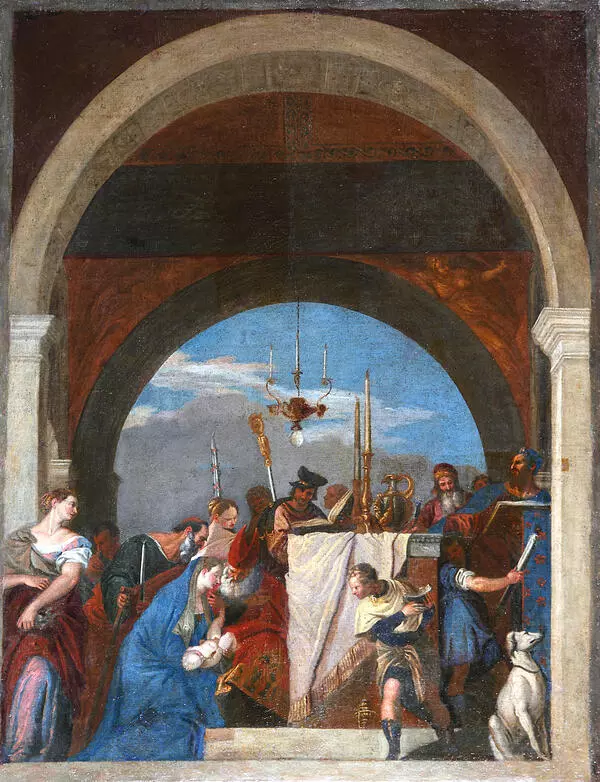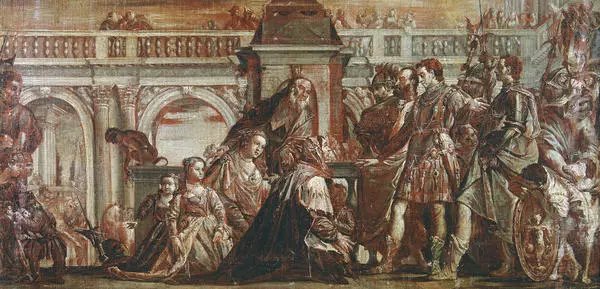Paolo Caliari, better known as Veronese (born in Verona) was an Italian painter, one of the brightest representatives of the Venetian school. He was the fifth of the sons of the sculptor and stonemason Gabriele Caliari and was trained by his uncle, the Venetian painter Antonio Badile. He later married his daughter.
In the middle of the 16th century Veronese painted plafonds in the Venetian Doge’s Palace, and afterward he decorated the church sacristy. This brought him great fame and a lot of commissions. Veronese worked in Rome, Mantua, Padua, his native Verona and other cities.
Like all representatives of the Venetian school, Veronese was primarily a colorist. He alternated between rich color patches and delicate shades, preferring a cold, silvery color scheme.
Veronese often painted portraits, less often landscapes, but he focused mostly on biblical subjects. Nevertheless, the painter’s works were quite daring: he dressed evangelical characters in modern Venetian attire and introduced a variety of secular motifs into his canvases.
The “Christ and the Sinner” (also known as “The Adulteress before Christ”) is executed in the same manner. According to the legend, the crowd brought to Christ an unfaithful wife, who, according to the law, was to be stoned. When Jesus was asked what to do with her, he replied, “Which of you is without sin, cast the first stone upon her” .
In the picture the artist dramatically moves his characters to the foreground, bringing them as close to the viewer as possible in order to make the images more dynamic. He uses a characteristic compositional structure: on both sides of the painting Veronese depicts lively and naturally moving figures, as if cut off by the frame. As a result of this “framing”, the scene stretches beyond the painting, but the canvas nevertheless becomes satisfyingly complete.
Veronese used his favorite techniques in this work: he built a composition of many figures filling the entire space, populating the religious canvas with his contemporaries and dressing them up.
When Veronese painted one of his pictures in this manner, he was questioned by the Holy Inquisition, which accused him of blasphemy. The artist managed to convince the church of his innocence, but after the trial the style of Caliari’s painting changed: his canvases became more muted and subdued, they lost their vividness and contrast.
In the middle of the 16th century Veronese painted plafonds in the Venetian Doge’s Palace, and afterward he decorated the church sacristy. This brought him great fame and a lot of commissions. Veronese worked in Rome, Mantua, Padua, his native Verona and other cities.
Like all representatives of the Venetian school, Veronese was primarily a colorist. He alternated between rich color patches and delicate shades, preferring a cold, silvery color scheme.
Veronese often painted portraits, less often landscapes, but he focused mostly on biblical subjects. Nevertheless, the painter’s works were quite daring: he dressed evangelical characters in modern Venetian attire and introduced a variety of secular motifs into his canvases.
The “Christ and the Sinner” (also known as “The Adulteress before Christ”) is executed in the same manner. According to the legend, the crowd brought to Christ an unfaithful wife, who, according to the law, was to be stoned. When Jesus was asked what to do with her, he replied, “Which of you is without sin, cast the first stone upon her” .
In the picture the artist dramatically moves his characters to the foreground, bringing them as close to the viewer as possible in order to make the images more dynamic. He uses a characteristic compositional structure: on both sides of the painting Veronese depicts lively and naturally moving figures, as if cut off by the frame. As a result of this “framing”, the scene stretches beyond the painting, but the canvas nevertheless becomes satisfyingly complete.
Veronese used his favorite techniques in this work: he built a composition of many figures filling the entire space, populating the religious canvas with his contemporaries and dressing them up.
When Veronese painted one of his pictures in this manner, he was questioned by the Holy Inquisition, which accused him of blasphemy. The artist managed to convince the church of his innocence, but after the trial the style of Caliari’s painting changed: his canvases became more muted and subdued, they lost their vividness and contrast.





